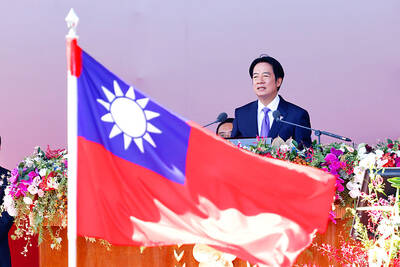Preparing for conflict with Taiwan — including deterring or defeating US intervention — remains the focus and “primary driver” of China’s military, a US Department of Defense annual report on China’s armed forces said.
The Chinese People’s Liberation Army (PLA) is also placing an emphasis on preparing for contingencies in the South and East China seas, the report released to the US Congress said on Thursday.
“As China’s interests, capabilities and international influences have grown, its military modernization program has also become increasingly focused on military investments for a range of missions beyond China’s coast, including sea lane security, counter-piracy, peacekeeping and humanitarian assistance,” the 100-page report said.
Although the dialogue between the US and China is improving, outstanding questions remain about the rate of growth in China’s military expenditures due to the lack of transparency regarding Beijing’s intentions.
Last year, China announced a 5.7 percent increase in its annual military budget to US$119.5 billion — continuing more than 20 years of sustained annual defense spending increases.
“As the US builds a stronger foundation for a military-to-military relationship with China, it also will continue to monitor China’s evolving military strategy, doctrine and force development and encourage China to be more transparent,” the report said.
“Dealing with a potential contingency in the Taiwan Strait remains the PLA’s primary mission despite an overall reduction of cross-strait tensions — a trend that continued following the re-election of Taiwan President Ma Ying-jeou [馬英九],” the report said.
Should conditions change, the PLA could be called upon to “compel” Taiwan to abandon possible moves toward independence or to “reunify” Taiwan with China by force of arms, it said.
Following Beijing’s leadership transition between 2012 and last year, China does not appear to have fundamentally altered its approach to Taiwan and despite “occasional signs of impatience” China appears content to respect Taiwan’s approach to cross-strait relations, the report said.
China is developing and testing several new classes and variants of offensive missiles, forming additional missile units, upgrading older missile systems and developing methods to counter ballistic missile defenses, it said.
China’s second artillery has deployed more than 1,000 short-range ballistic missiles to garrisons across from Taiwan and is fielding cruise missiles.
“Security in the Taiwan Strait is largely a function of dynamic interactions between and among mainland China, Taiwan and the US,” the report said.
China’s strategy toward Taiwan has been influenced by what it sees as positive developments in Taipei’s political situation and approach to engagement with Beijing, it said.
The report says that the two sides have made progress in expanding cross-strait trade, economic links, and people-to-people contacts, but that China’s overall strategy continues to “incorporate elements” of persuasion and coercion to deter or repress Taiwanese independence.
There are no signs that China’s “military disposition” toward Taiwan has changed, the report said.
“The PLA has continued to develop and deploy military capabilities to coerce Taiwan or to attempt an invasion, if necessary,” it said.
It says that China appears prepared to defer the use of force as long as it believes that unification over the long term remains possible and the costs of conflict outweigh the benefits.
“The PLA is capable of increasingly sophisticated military action against Taiwan,” the report said.
“It is possible China would first pursue a measured approach characterized by signaling its readiness to use force, followed by a deliberate buildup of force to optimize the speed of engagement over strategic deception,” it said.
The report said that another option would be for China to sacrifice overt, large-scale preparations in favor of surprise to force rapid military or political resolution before other countries could respond.
“China today probably could not enforce a full military blockade, but its ability to do so will improve significantly over the next five or 10 years,” the report said.
In a limited campaign against Taiwan, China might use a variety of disruptive, punitive or lethal military actions in conjunction with overt and clandestine economic and political activities.
A campaign could include computer networks or limited kinetic attacks against Taiwan’s political, military and economic infrastructure to induce fear and degrade confidence in the Taipei leadership.
Large-scale amphibious invasion, the report said, is one of the most complicated and difficult military operations and an attempt to invade Taiwan would “invite international intervention.”
This would be a significant political and military risk, it said.
Moreover, China does not appear to be building the conventional amphibious lift required to support such a campaign, it said.
The report says that the second artillery is prepared to conduct missile attacks and precision strikes against Taiwan’s air defense systems, air bases, radar sites, missiles, space assets and communications facilities in an attempt to degrade Taiwan’s defenses, neutralize the nation’s leadership or break the public’s will to fight.
Meanwhile, the PLA air force has stationed a large number of advanced aircraft within close range of Taiwan, providing a significant capability to conduct air superiority and ground attack operations.
The PLA navy is improving anti-air and anti-surface warfare capabilities, developing a credible at-sea nuclear deterrent and introducing new platforms that are positioned to strike Taiwan.
PLA ground forces are conducting joint training exercises that are to prepare them for a Taiwan invasion scenario.
The report said that Taiwan has historically relied upon multiple military variables to deter PLA aggression: the PLA’s inability to project sufficient power across the Taiwan Strait, the nation’s military’s technological superiority and the inherent geographic advantages of island defense.
Yet, the report said, China’s increasingly modern weapons and platforms of more than 1,200 ballistic missiles, an anti-ship ballistic missile program, ships, submarines and combat aircraft “have eroded or negated many of these factors.”

People can preregister to receive their NT$10,000 (US$325) cash distributed from the central government on Nov. 5 after President William Lai (賴清德) yesterday signed the Special Budget for Strengthening Economic, Social and National Security Resilience, the Executive Yuan told a news conference last night. The special budget, passed by the Legislative Yuan on Friday last week with a cash handout budget of NT$236 billion, was officially submitted to the Executive Yuan and the Presidential Office yesterday afternoon. People can register through the official Web site at https://10000.gov.tw to have the funds deposited into their bank accounts, withdraw the funds at automated teller

PEACE AND STABILITY: Maintaining the cross-strait ‘status quo’ has long been the government’s position, the Ministry of Foreign Affairs said Taiwan is committed to maintaining the cross-strait “status quo” and seeks no escalation of tensions, the Ministry of Foreign Affairs (MOFA) said yesterday, rebutting a Time magazine opinion piece that described President William Lai (賴清德) as a “reckless leader.” The article, titled “The US Must Beware of Taiwan’s Reckless Leader,” was written by Lyle Goldstein, director of the Asia Program at the Washington-based Defense Priorities think tank. Goldstein wrote that Taiwan is “the world’s most dangerous flashpoint” amid ongoing conflicts in the Middle East and Russia’s invasion of Ukraine. He said that the situation in the Taiwan Strait has become less stable

CONCESSION: A Shin Kong official said that the firm was ‘willing to contribute’ to the nation, as the move would enable Nvidia Crop to build its headquarters in Taiwan Shin Kong Life Insurance Co (新光人壽) yesterday said it would relinquish land-use rights, or known as surface rights, for two plots in Taipei’s Beitou District (北投), paving the way for Nvidia Corp to expand its office footprint in Taiwan. The insurer said it made the decision “in the interest of the nation’s greater good” and would not seek compensation from taxpayers for potential future losses, calling the move a gesture to resolve a months-long impasse among the insurer, the Taipei City Government and the US chip giant. “The decision was made on the condition that the Taipei City Government reimburses the related

FRESH LOOK: A committee would gather expert and public input on the themes and visual motifs that would appear on the notes, the central bank governor said The central bank has launched a comprehensive redesign of New Taiwan dollar banknotes to enhance anti-counterfeiting measures, improve accessibility and align the bills with global sustainability standards, Governor Yang Chin-long (楊金龍) told a meeting of the legislature’s Finance Committee yesterday. The overhaul would affect all five denominations — NT$100, NT$200, NT$500, NT$1,000 and NT$2,000 notes — but not coins, Yang said. It would be the first major update to the banknotes in 24 years, as the current series, introduced in 2001, has remained in circulation amid rapid advances in printing technology and security standards. “Updating the notes is essential to safeguard the integrity